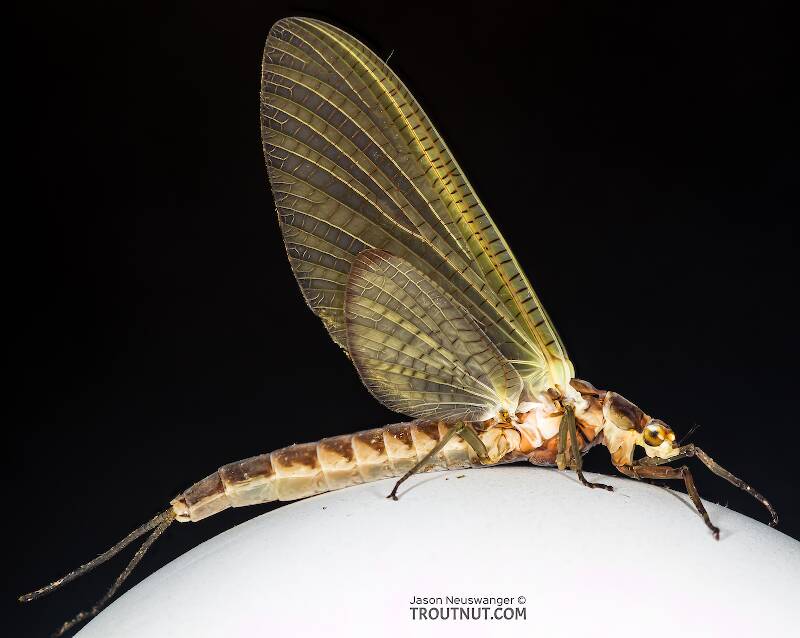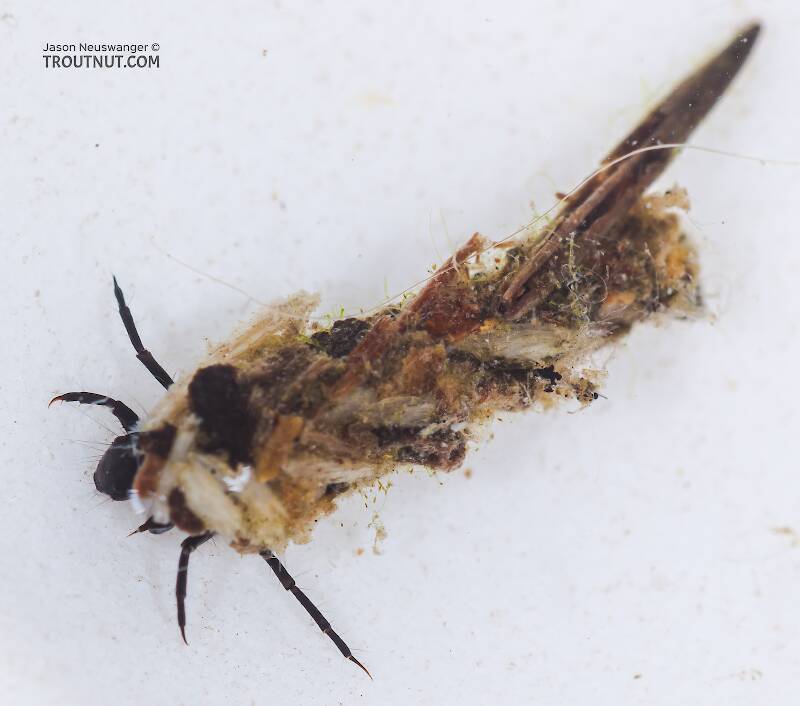
Hex Mayflies
Hexagenia limbata
The famous nocturnal Hex hatch of the Midwest (and a few other lucky locations) stirs to the surface mythically large brown trout that only touch streamers for the rest of the year.
Featured on the forum

This seems to be a young larva of Limnephilus. Although not clear in the picture, several ventral abdominal segments have chloride epithelia.

Troutnut is a project started in 2003 by salmonid ecologist Jason "Troutnut" Neuswanger to help anglers and
fly tyers unabashedly embrace the entomological side of the sport. Learn more about Troutnut or
support the project for an enhanced experience here.
Identification: Key to Genera of Glossosomatidae Larvae, Couplet 3
Identification: Key to Genera of Glossosomatidae Larvae, Couplet 3
Error: Tried to access a key that isn't live.
Adapted from Merritt R.W., Cummins, K.W., and Berg, M.B. (2019)
This couplet refers figures (usually designated 'sf') from this source.
You will need the source (make sure to get the same edition!) to see them.
This couplet refers figures (usually designated 'sf') from this source.
You will need the source (make sure to get the same edition!) to see them.
| Option 1 | Option 2 |
|---|---|
| Each tarsal claw apparently trifid, with 3 points subequal in length (sf 19.161) | Each tarsal claw with normal single point, basal seta and basal process much smaller (sf 19.162, 19.163) |
| Southeast | |
| Remaining genera: Culoptila and Protoptila | |
| Padunia Species Padunia jeanae No further information about this genus is available on Troutnut.com at this time. | Go to Couplet 4 |
Adapted from Merritt R.W., Cummins, K.W., and Berg, M.B. (2019)
The current couplet is highlighted with darker colors and a icon, and couplets leading to this point have a icon.
Leads to Couplet 2:
- Mesonotum with 2 or 3 sclerites (sf 19.156, 19.157, sometimes hard to see)
- Head with ventromesal margins of genae not thickened
- Posterior median ventral ecdysial line about 1.5 times as long as each anterior divergent branch (sf 19.159, 19.160)
- Anal opening without dark, sclerotized line on each side
Couplet 2
Leads to Couplet 5:
- Mesonotum without sclerites
- Head with ventromesal margins of genae thickened
- Posterior median ventral ecdysial line about as long as each anterior divergent branch (sf 19.158)
- Anal opening with dark, sclerotized line on each side (sf 19.60, 19.164)
Couplet 5
Couplet 3 (You are here)
Leads to Padunia
(Padunia jeanae):
(Padunia jeanae):
- Each tarsal claw apparently trifid, with 3 points subequal in length (sf 19.161)
- Southeast
Padunia
(Padunia jeanae)
(Padunia jeanae)
Leads to Couplet 4:
- Each tarsal claw with normal single point, basal seta and basal process much smaller (sf 19.162, 19.163)
Couplet 4
Leads to Protoptila:
- Basal seta of each tarsal claw long, thin, and arising from side of stout basal process (sf 19.163)
- Case constructed with some relatively large stones (sf 19.167)
- Widespread
Leads to Glossosoma:
- Pronotum excised 1/3rd anterolaterally to accommodate coxae (sf 19.165)
- Dome-like case of stones with transverse ventral strap of finer sand and interchangeable ends (sf 19.38, 19.459a, 19.459b)
- Widespread
Leads to Anagapetus:
- Pronotum excised 2/3rds anterolaterally to accommodate coxae (sf 19.166)
- Case similar to that at left
- West
Anagapetus
Start a Discussion of this Couplet
References
- Merritt R.W., Cummins, K.W., and Berg, M.B. 2019. An Introduction to the Aquatic Insects of North America (Fifth Edition). Kendall/Hunt Publishing Company.

